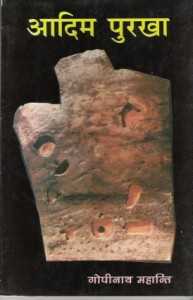Adim Purkha
 | |
| Author | Gopinath Mohanty |
|---|---|
| Original title | Dadi Burha (Oriya) |
| Translator | Binod Bihari Verma |
| Country | India |
| Language | Maithili |
| Genre | Novel, |
| Publisher | Sahitya Akademi |
Publication date | 2001 |
| Media type | Print (Paperback) |
| Pages | 96 pp |
| ISBN | ISBN 81-260-1215-3 |
| Preceded by | Nayanmani |
| Followed by | Vedmurti Taponishth SriRam Sharma Acharya(2005) |
Adim Purkha is the Maithili translation of Oriya novel Dadi Burha, written by Gopinath Mohanty and published by Sahitya Akademi. The work has been translated into Maithili by Dr. Binod Bihari Verma.
Theme of the novel Dadi Budha
Dadi Budha (1944) is one of the shorter novels of Gopinath Mohanty. It has the distinction of being his first novel based on tribal life. The novels tells the moving story of the disintegration of a tribal community under the impact of modern civilization. Dadi Budha is an ancient datepalm tree representing the eternal ancestor; it stands for the cultural heritage of the tribal people manifest in their rituals and costumes. The tree stands as a silent witness to the joys and sorrows of the tribal folk; it dominated the drama of their existence. Close to Dadi Budha stands a termite mound called Hunka Budha, yet another symbol of the primitive and innocent faith of tribal people.
Thenga Jani, the son of Ram Chandra Muduli, the headmen of Lulla village, is beteothed to a beautiful girl, Saria Daan, the only daughter of the same village. But he comes under the spell of Sanotsh Kumari, a Christian Domb girl. Thenga and Santosh deeply in love and reject the discipline of the tribal society. They decide to run away to Assam to work on a tea estate; they planned to build their dream home in a town where the rule of the tribal society does not prevail. Gopinath visualizes life tribal community against a cosmic background. The despair of Ram Muduli, the plight of Thenga mother after her only son leaves the village with the Domb girl, the declaration of the dishari that Thenga and Santosh were evil dumas, the terror caused by the tiger and the rise of a village at another site all these signify the unbroken continuity of life .
Tribal life in Gopinath’s novels
In his portrayal of tribal life, Gopinath Mohanty invites comparison with the Nigerian novelist, Chinua Achebe. At one level, their visions are almost identical: they visualize the disintegration of a primitive community under the impact of a new faith or an alien value-system. But to see the disintegration of Lulla village (In the novel, Dadi Budha) and the tribal community in Umuofia (In Things Fall Apart) as parts of the same process of change is to play down the role of colonialism as an agent of disruption. Achebe’s allusion to W.B. Yeats is not a gesture of submission; it interrogates its cosmic, universalist vision of change. Although Gopinath does not directly refer to Yeats, he also focuses the traumatic expression of colonialism in his work.
Gopinath’s Dadi Budha and other novels in English
The Ancestor , the translation of Gopinath’s Dadi Budha , has been brought out by the Sahitya Akademi . Four of Gopinath’s novels – Paraja , Danapani , Laya Bilaya and Dadi Budha – have appeared in English translation. The first three have been translated by Bikram K. Das and the last mentioned one of Arun Kumar Mohanty. The English version of Paraja was published by Faber and Faber (U.K.) and Oxford University Press (India) in 1987.The Survivor , the English translation of Danapani , was published by Macmillan India Limited in 1995. The translation of Laya Bilaya which bears the title, High Tide , Ebb Tide, has been published by Lark Books . . The Ancestor , the translation of Gopinath’s Dadi Budha , has been brought out by the Sahitya Akademi . Besides, a number of short stories of Gopinath have also been translated. It is extremely difficult to render in English the nuances of Gopinath Mohanty’s language. However, translators have attempted to convey the richness and complexity of the original texts to readers unfamiliar with Oriya.